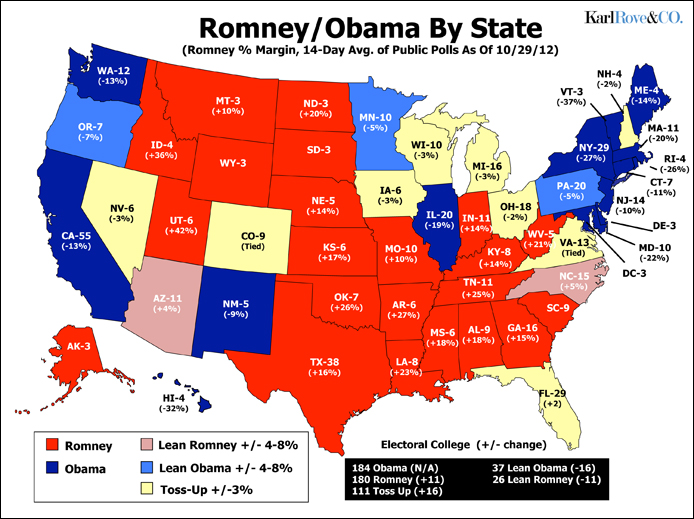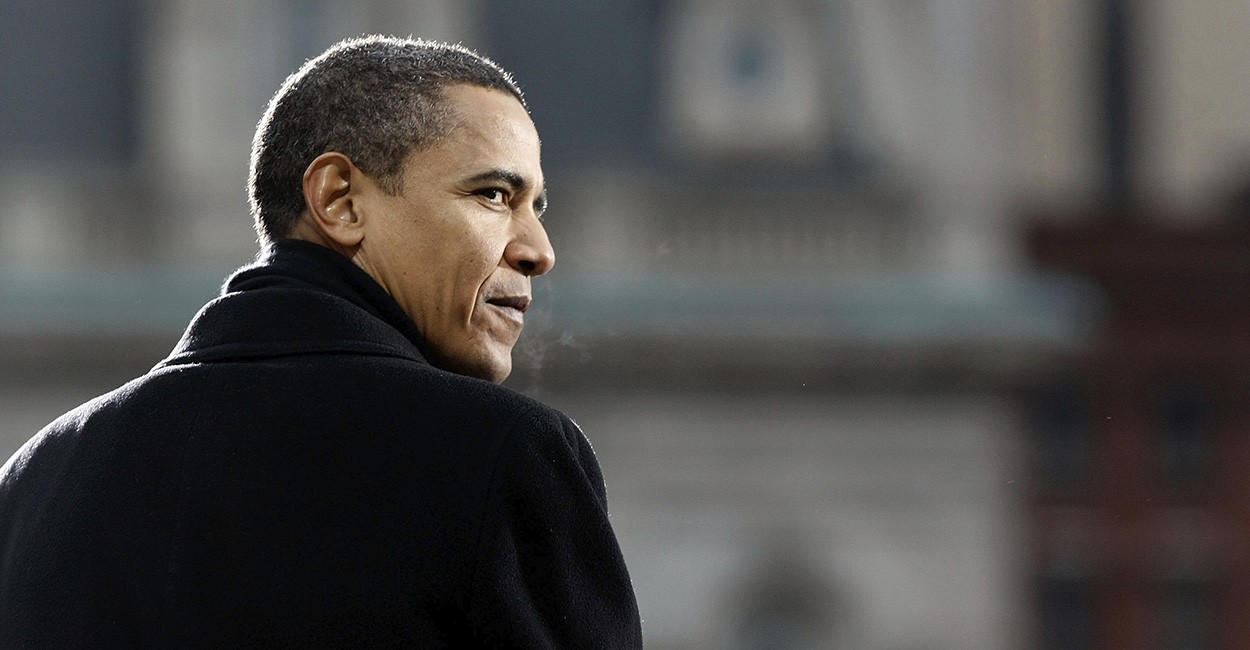By: Uzma Chowdhury
Although Halloween slipped away in the wee hours of last night—the candy eaten, the costumes packed up—for many Americans the real tri
cks and treats have yet to come—and they might just be far more terrifying and thrilling than the hauntings of All Hallows Eve. It’s officially November, and in five short days the battle of Obama vs. Romney will have an officially declared victor. The current results from polls are indicating a very close race, showing no clear advantage for either candidate. Though Romney is leading in polls conducted by RCP, NPR, Rasmussen, and Gallup, he’s leading by a very minimal amount; his lead ranging from 0.9 to 2 points, except according to Gallup, where he’s leading by 5 points. Obama is leading according to both IBD and Politico by 1 point. Pew and ABC News has the candidates currently tied. However, these polls reflect the popular vote, which, as the 2000 election indicates, may not always predict a clear winner. Pundits have predicted this race to be close, but as Election Day draws nearer, the results are still very much up in the air and the possibility of a tie seems more and more possible. Though a confirmed victor will not be announced until next Tuesday, current candidate approval in the swing states indicate what results we might expect. A presidential candidate needs 270 of a possible 538 electoral votes to win the election; the swing states are crucial in allowing a candidate to reach that Holy Grail of 270, and in a race as close as this once, every state counts.
The 2012 battleground states are Florida (29 electoral votes), Pennsylvania (20 electoral votes), Ohio (18 electoral votes), Michigan (16 electoral votes), North Carolina (15 electoral votes), Virginia (13 electoral votes), Wisconsin (10 electoral votes), Colorado (9 electoral votes), Nevada (6 electoral votes), Iowa (6 electoral votes), and New Hampshire (4 electoral votes). These eleven swing states offer a total of 146 electoral votes. That’s 146 votes that could go to either candidate—potentially making or breaking this election for Romney or Obama.
According to 270towin.com, Obama currently has 146 safe votes, 38 likely votes, and 33 lean votes, giving him a total of 217 votes. Romney has 93 safe votes, 41 likely votes, and 57 lean votes, giving him a total of 191. That leaves 130 toss up votes that are necessary to reach 270—all of which are dependent on the votes from these battleground states. Based on current polling averages, Obama’s best chance at victory is if he wins Pennsylvania, Ohio, Michigan, Wisconsin, and Nevada or Iowa. Another likely combination for his victory is if he wins Florida, Pennsylvania, Michigan, and Wisconsin. Romney’s chances are best if he wins Florida, Ohio, North Carolina, Virginia, and Colorado. Additionally, he could also win the presidency by winning Florida, Ohio, North Carolina, Virginia, and Wisconsin. While all of these states are necessary, it’s clear that Romney needs Florida to win and both candidates need Ohio to win. Currently all Florida polls show Romney leading Obama 50% to 49%. In Ohio, Romney is leading Obama 50% to 48%, according to Rasmussen. Florida and Ohio, historically as well as in 2012, are crucial. No Republican candidate has ever won an election without having carried Ohio. The presidential election may very well be determined by how Cleveland rocks (the vote) this year.
It takes 270 to win, but what happens if there is a tie? There are still 32 potential (and increasingly probable) tie outcomes. There will obviously be a frenzy of recounts, but what if results are still unclear after that process is over? According the to the Constitution, there’s a quick fix for that—if each candidate somehow gets 269 electoral votes a piece, then the House elects the president and the Senate elects the vice-president. Given the current majority parties in each, we’d then have a Romney/Biden ticket. Scary, right? Happy Halloween, America! Yet it is the newly elected House that casts the vote so there’s still no way to know for sure. We might even bring in an Obama/Ryan ticket. To further complicate issues, what happens if the House ties in their decision to choose the president? In that situation, the vice-president would have to act as president until the tie was broken, but that vice-president would only be officially vice-president if elected by the new Senate. Because of that complication, the standing president would become the House speaker, Republican John Boehner. If there is a tie in the Senate, then the vice-president breaks the tie in his role as President of the Senate. So then Joe Biden would vote for …well…Joe Biden.
And if all of this does come to pass, what does that mean for the American people? Everyone still cringes about the messy 2000 election—but this could be so much worse. The tricky dynamics of party loyalty and gridlock further complicate this situation. While the protocol is clearly outlined in the Constitution, will voters be outraged at this procedure that essentially dismisses the ballots of everyone who turns out on November 6th? Or will the results be accepted with trust in the framers of the original Constitution? Given the current state of polarization in our nation, it’s hard to believe a split ticket in the Oval Office would sit well with our citizens. Maybe a 2012 tie would be the final straw in the battle against the Electoral College. Maybe the winner of 2012 won’t be Romney/Ryan or Obama/Biden—just maybe 2012’s victor will be a two-party ticket, and maybe 2012’s victor will be a cold turkey, national step away from polarization and in favor of non-partisanship. We can’t know for sure right now. Only the headlines on November 7th will tell, and that’s just six short days away.

